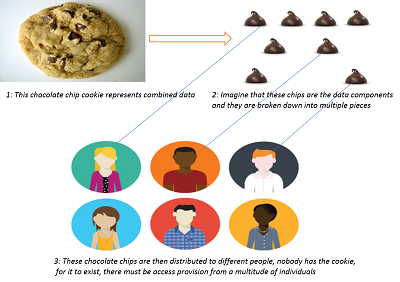There is a ton of complex content online explaining blockchain, involving fancy webs and futuristic illustrations which are difficult to process. Blockchain is a lot simpler than that, think of it like a large set of data and information that is to be digitally stored, break that data down into small pieces, and distribute it across different platforms and users. Now, you may think that somebody else can access your data, except that will not happen because every user or platform across which small pieces of your data have been distributed is encrypted using a technique called cryptography. Moreover, the threat of your data and/or information being preserved in one set is that others can edit it or modify it, or even delete it! Blockchain prevents that from happening by ensuring that every broken-down piece of data of yours is only accessible to the user who has access to the key which can unlock access to modification of the fragmented pieces of information. The diagram below explains the process employed by blockchain technology using a cookie.
This represents the “decentralized” application feature of blockchain technology, this can create greater trust among users for a large quantum of services and processes. Lousily, this article could be ended by a claim that blockchain will revolutionize the world and will have applications in all industries, and it would not be a lie. However, let’s look at the context of India and where a technology such as this can be used in India. Given that cryptocurrency is still being investigated by the government as legal tender, this article will not be focusing on the application of blockchain in cryptocurrencies, rather on the applications in fields like manufacturing, banking, healthcare, supply chain management and decentralization of ledgers.
Satoshi Nakamoto (pseudonym) came up with this peer-to-peer electronic transfer system requiring participation from more and more individuals to make data more encrypted, therefore safer and the process more viable in terms of cost management of its implementation.

Millions of lines of code are what somebody who wants to hack through blockchain technology will have to get through, while also being able to access a mammoth of participants to get all the data that they may want. It’s first application in India can be for transforming accounting processes wherein every transaction can be recorded the minute it happens, at whichever level it happens, with safe transfer of information without possibility of fraudulent activities in the multitude of levels that an accounting figure may have to come through before entering the books. Elimination of middlemen would remove the requirement of huge costs in professionals like auditors as well as non-value-adding tasks like immediate bookkeeping need not exist. Moreover, compliances can be simply taken care of by making changes in the rules that the information goes through and is then digitally stored. So, for all the businessmen and women facing problems as GST rates are revised, all that then needs to be changed is an entry in the platform of a rule.
The trust gap between people and the banking system has increased substantially since the 2008 financial crisis, fraudulent activities within companies can be taken care of accounting applications that employ blockchain, which can be used for facilitation of public auditing of corporate accounts. Other problems that blockchain can solve include reduction in identity theft with maximum transparency of what is happening to people’s data without making the data of individuals visible to people. Further reducing the trust issues that the people may have with the system.
India faces a huge problem of food and waste management, supply chain management using block chain where there can be storage of information with regards to food distribution and the levels through which that food product is travelling along with simple and ancient technologies like economic order quantity programs can be used together to ensure faster and efficient distribution of food grains, vegetables and fruits in India while also making price points more accessible to the poor, thereby facilitating healthier consumption across the state.
Blockchain storage is best for an ideal world wherein we can strive for consumer-business relationships to be based on utmost good faith wherein we can set up platforms for health data and health activity of an individual to be stored on their personal blockchain while not making that available to the public but should the individual lie to business entities like insurers or their medical consultants, the technology can facilitate for investigation, this can revolutionize the insurance industry by massively decreasing false claims, therefore reducing premiums, thereby making insurance too accessible to more people.






